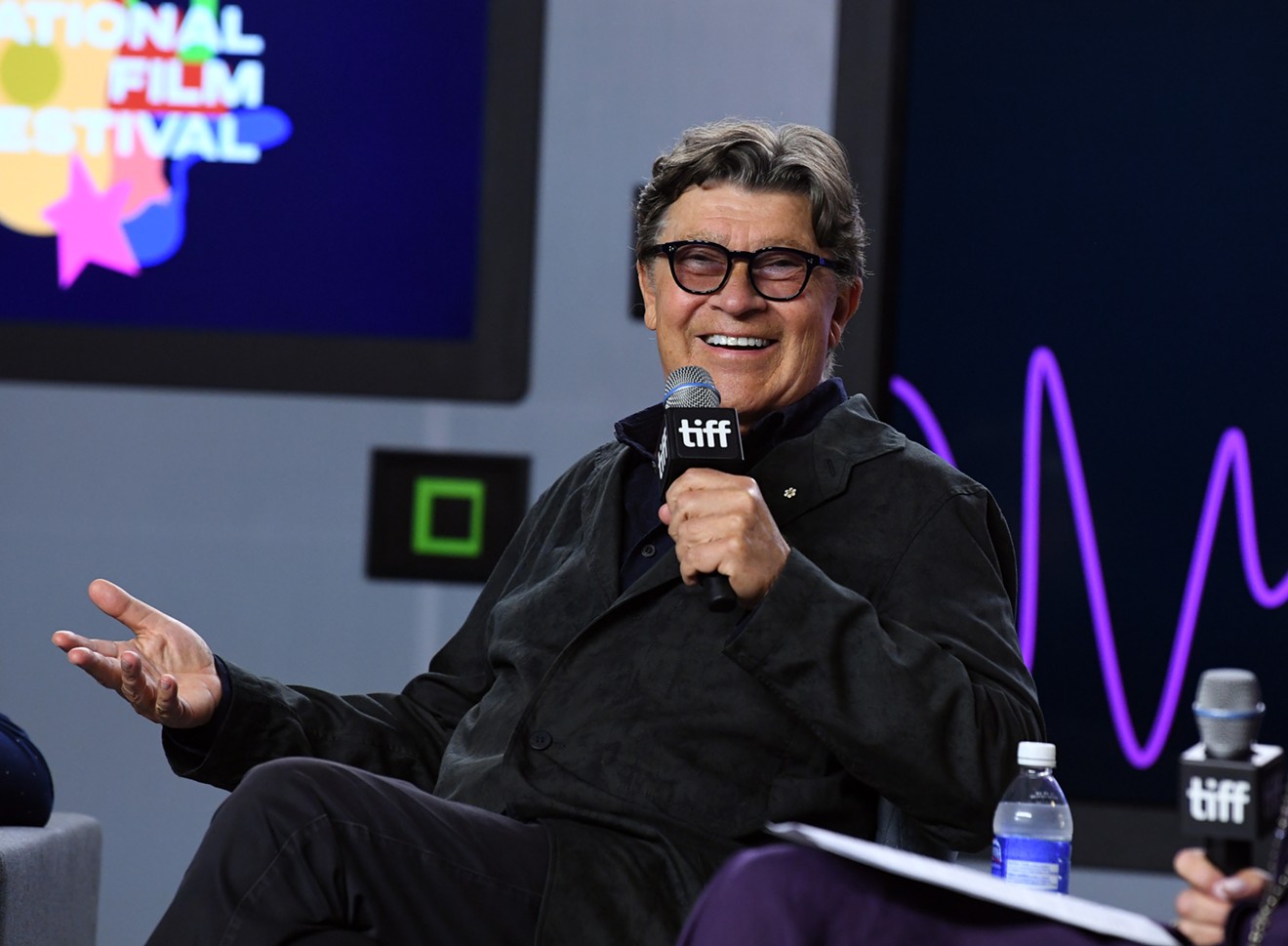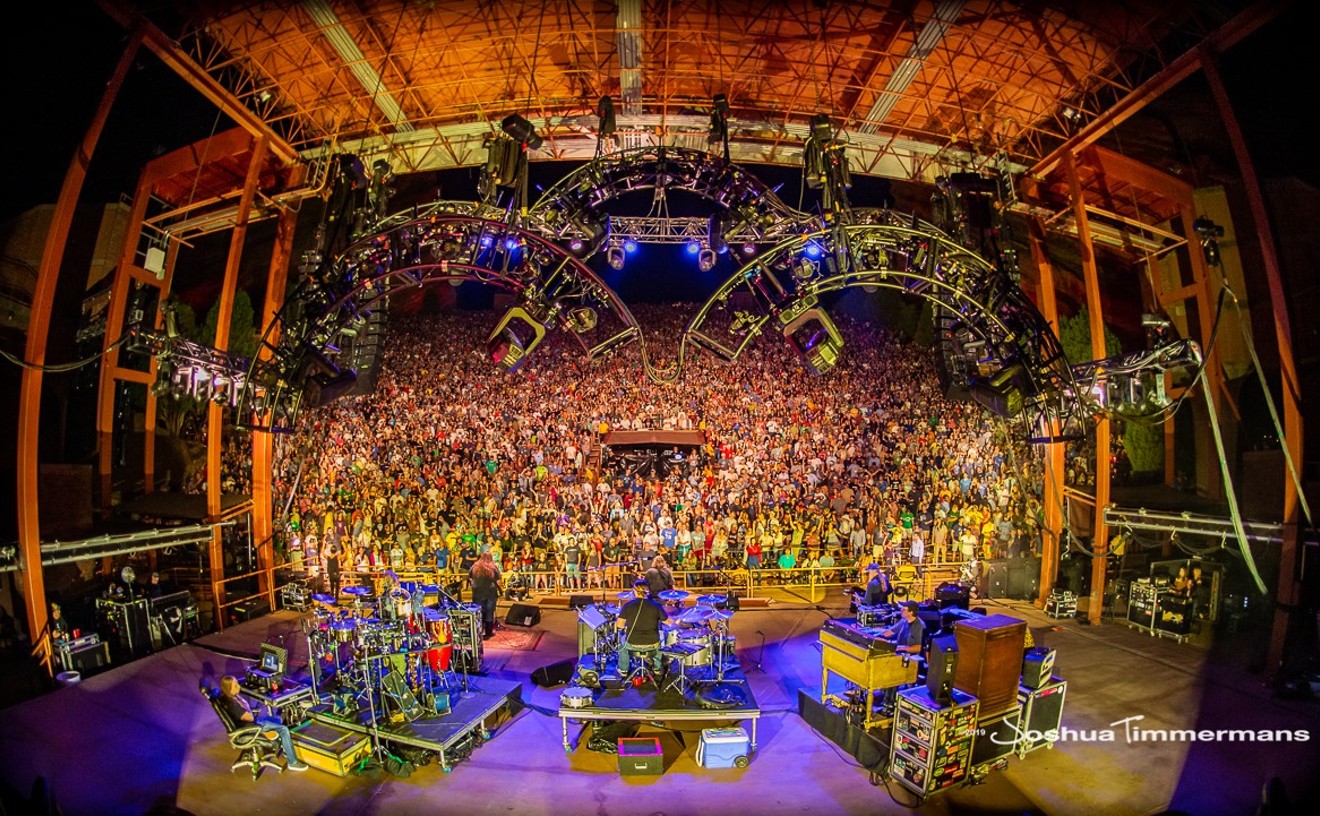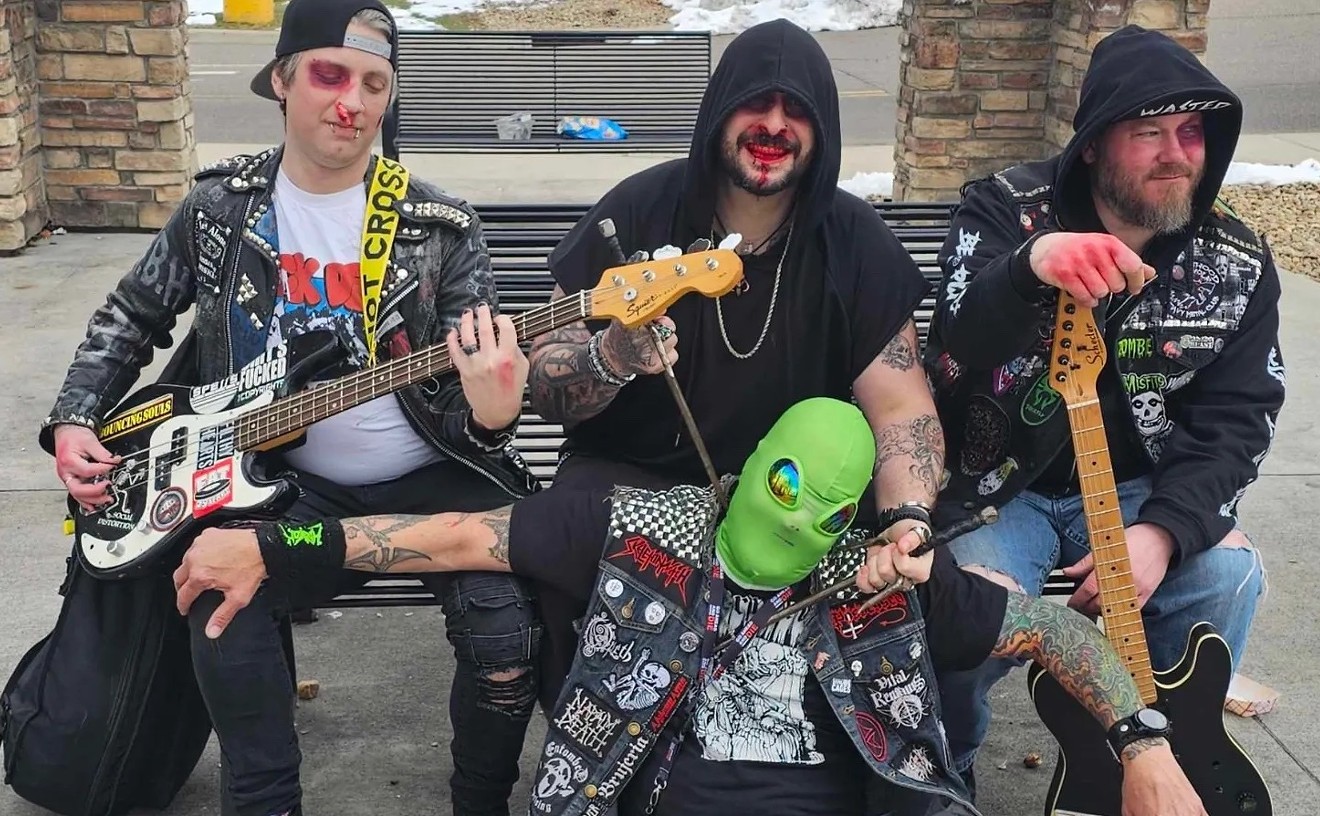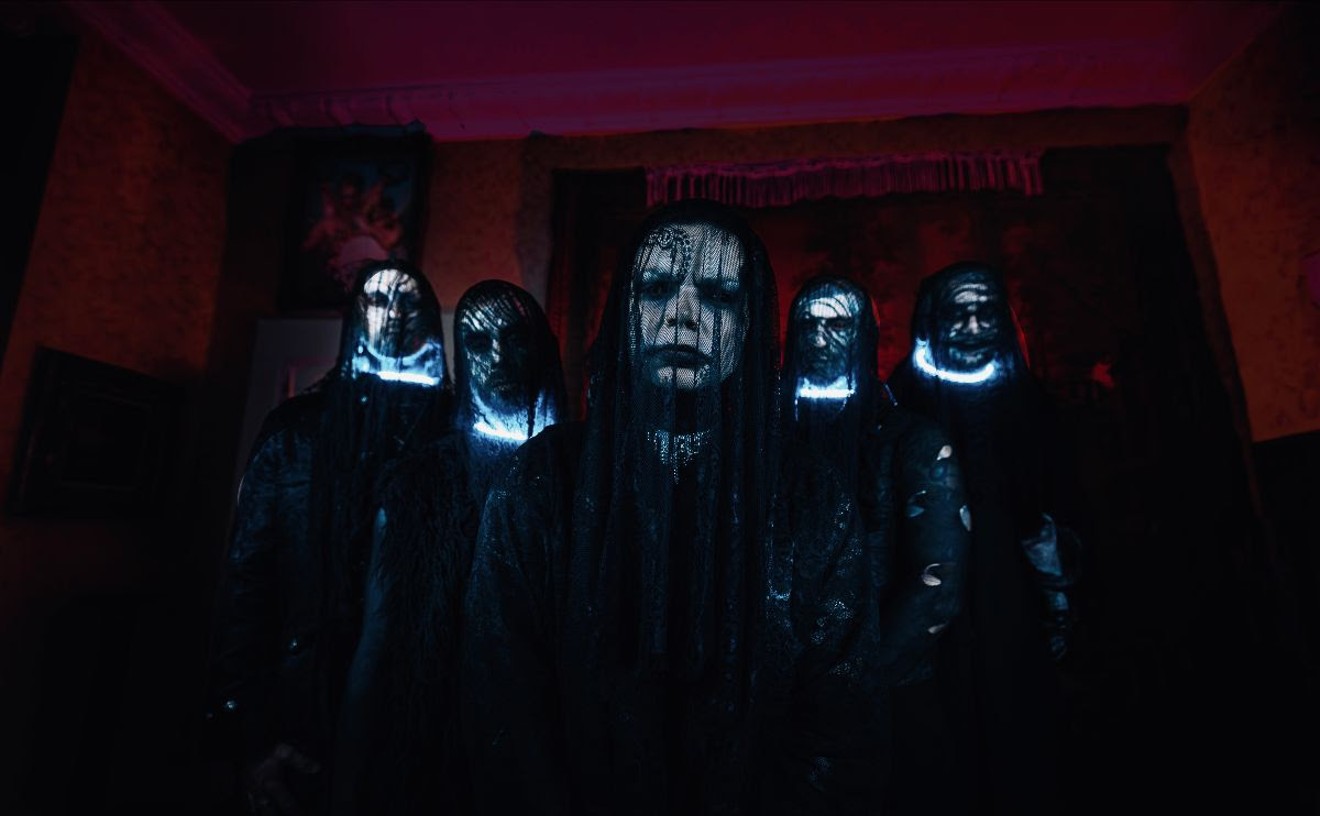It was exciting news that Robbie Robertson was scheduled to perform on August 20 at Boulder's Fox Theatre as part of a showcase tied into the Gavin A3 Summit, an annual radio conference sponsored by Gavin, a powerful music-industry tip sheet. After all, Robertson is one of the most important figures in rock history, thanks in large part to his work with Bob Dylan and the Band, yet he plays live about as often as Rush Limbaugh gladhands Ted Kennedy. But several weeks after Robertson's appearance was announced, he abruptly canceled it (Bonnie Raitt now headlines the show in his place). He says scheduling conflicts were the main culprits; a number of musicians with whom he's been collaborating were unavailable to join him. "And this is not pickin' and a-singin' kind of music, you know," he says about the complex, multi-layered sound of his latest disc, Contact From the Underworld of Redboy. "You can't just go, 'Okay, we'll do this acoustic.' It is what it is."
That said, Robertson isn't exactly boo-hooing over his inability to showcase at a convention. He's eager to promote both Redboy and Making a Noise: A Native American Spiritual Musical Journey, a documentary about Robertson's rediscovery of his cultural background that's beginning to air on PBS stations across the country. (The program can be seen on KRMA-TV/ Channel 6 on Tuesday, September 1, at 7 p.m. It debuted on KBDI-TV/Channel 12 on August 15 and will likely be repeated.) However, the prospect of traveling across the country to rock the house no longer holds much romance for him.
"Years ago with the Band, I made a movie and a statement about giving up the road called The Last Waltz," he notes, referring to a 1978 flick (directed by Martin Scorsese) that's widely considered one of the greatest rock films ever made. "And when I did that, I wasn't really kidding. I thought, I've been doing this since I was a young kid. I was on the road with these guys for sixteen years as the Hawks and then the Band. And it was like, I'm not growing from this. It's just a business. You go out, you play, you collect money, you go to the next place, and you collect money. And I really had a feeling, and this is way back when, that all of this about connecting with the people—I mean, do you think the Rolling Stones are connecting with the people? And do you think the Eagles got back together again because of the music? Horseshit. It's all about money. And I thought, I don't want to go around from town to town taking money unless I'm passionate about what I'm doing.
"I don't know, maybe some people, like Willie Nelson, Bob Dylan and Johnny Cash, just love it and want to do it forever. But for me, it got to where I thought that if I'm not learning something from this, if I'm not drawn to this thing, if this is really only about my pocketbook, then I shouldn't do it. For me, the thing that I'm really passionate about is taking something out of the air that didn't exist and making it exist musically. That appeals to me. It makes me feel a sense of something a lot more than somebody writing me a check."
Statements like this one tend to stir up suspicion: Even artists actively looking for the next opportunity to sell out tend to make them. But such declarations mean much more coming from Robertson. Born Jaime Robbie Robertson in Canada 55 years ago, he was raised mainly in Toronto, but between 1954 and 1957 he spent his summers at the Six Nations Reservation, where his mother, of Mohawk descent, was raised. He learned to play guitar at Six Nations, and by the late Fifties, he was playing in bands such as Robbie & the Robots and Thumper & the Trambones. Shortly thereafter he joined the Hawks, a group that backed up rockabilly vocalist Ronnie Hawkins. That association ended in 1963, but Robertson and fellow Hawks Richard Manuel, Rick Danko, Levon Helm and Garth Hudson stuck together, and two years later the players came into the orbit of Dylan just as he was entering one of his most fruitful creative periods.
After Robertson contributed to Dylan's 1966 opus Blonde on Blonde, he and the Hawks supported the singer throughout a lengthy international tour that thrilled the rock faithful every bit as much as it distressed folk purists who saw Dylan's decision to electrify his sound as apostasy. Upon the junket's conclusion (and following a reported motorcycle accident), Dylan regathered the Hawks for a series of recordings made in a pink house located in West Saugerties, New York. The songs weren't meant for release, but bootleggers had other ideas. They circulated so many copies of the rich and wonderful tunes that bubbled forth from these sessions that Dylan's label, Columbia, eventually put out a portion of them in 1975 under the title The Basement Tapes. As indicated by the publication last year of Invisible Republic: Bob Dylan's Basement Tapes, a tribute book by journalist Greil Marcus, reverence for the tracks has not faded with the passage of time.
The Band (the handle the Hawks assumed in 1968) soon proved it didn't need Dylan to make great records. The outfit's bow, 1968's Music From Big Pink, was a fine introduction, and 1969's The Band, highlighted by "The Night They Drove Old Dixie Down" and "King Harvest (Has Surely Come)," sounded even better; the album is so deeply rooted in the type of North American music Robertson first absorbed while north of the border that it stubbornly refuses to date. A handful of subsequent platters (especially 1970's Stage Fright and 1972's Rock of Ages) were also first-rate, and although a collaboration with Dylan on the 1974 studio platter Planet Waves didn't hit anticipated heights, the same year's live Before the Flood showed that the remarkable connection between Dylan, Robertson and the rest remained very much intact. But Robertson was becoming restless, and after staging The Last Waltz (which included guest appearances by Dylan, Joni Mitchell, Neil Young and Van Morrison) and participating in 1977's Islands, his final studio excursion with the Band, he set off on his own.
In the more than two decades since, Robertson has overseen the soundtracks for the Scorsese films Raging Bull, King of Comedy, The Color of Money and Casino; acted in 1979's Carny alongside Gary Busey and Jodi Foster and in 1994's The Crossing Guard with Jack Nicholson; and put out two well-reviewed but modest-selling solo platters, 1987's Robbie Robertson and 1991's Storyville. But it was the opportunity to assemble the score for 1994's The Native Americans, a history of Native Americans made for the cable channel TBS, that laid the groundwork for Contact From the Underworld of Redboy and Making a Noise. All three efforts allowed Robertson to dive into the literal and metaphysical environments that helped shape him but that he wasn't always comfortable revisiting.
"When my mother was growing up, her aunt from Toronto told her, 'If you're going to get ahead, you need to lose the Indian thing,'" he says. "And when she'd go for a job or to meet people, her aunt said, 'Don't even bring up the Indian thing. That's the way it works out here in the world.' Now, when I was growing up, it wasn't like that; it wasn't like I was told 'You've got to hide this.' But her experiences, and the experiences of some of my other relatives, had a profound effect on me. There's a famous phrase that applies to this: 'Be proud that you're an Indian, but be careful who you tell.'"
When Robertson became a public figure, he didn't go out of his way to conceal his Indian heritage, but neither did he trumpet it. "In the Sixties there was this whole thing with the peaceniks and the beatniks and the hippies and all of that who wanted to go back to an Indian way of life—and even though they meant well about it, they didn't get it. So that made me feel better about things than I had, but still a little bit weird. And people would also make jokes. Not mean jokes—not redboy jokes—but jokes in regard to things that Indians are supposed to know, like, well, 'Why don't you ask Robbie? He's the Indian.' It wasn't mean-spirited, but nevertheless, it didn't make me say, 'Yeah, I'll cover that for you.' It made me think, don't bother me, please—because it wasn't the right kind of support or encouragement. And then there was the whole romanticism of things, where everyone thought of Indians in this completely romantic, corny, stereotypical, cliched kind of way—like the Indian on the hill with his arm raised against the sunset. That brought out a whole denial thing, a big guilt and denial thing."
Overcoming these feelings was a gradual process, Robertson says. "It wasn't a single incident at all, but a culmination of a whole bunch of things," he says. "I saw books starting to be published, and there was an openness that I could hear in people's conversations and attitudes that I could hear, and that was different from before. I could hear a respect factor—a respect for people who understood that God is the earth and the sky and the gift of life. It all added up to an awareness, a different kind of caring, and it made me believe that now would be the time to share some of the things that I've been carrying around with me my whole life. Because you can't share something if nobody else wants to share it. If that was the case, the idea of making a record and doing a documentary like this that would never be seen and never be heard would be too heartbreaking."
In On Contact From the Underworld of Redboy, Robertson touches upon a slew of Indian-oriented themes: Witness "Sacrifice," featuring a spoken-word interlude by jailed activist Leonard Peltier; "The Code of Handsome Lake," a narrative that condenses a Six Nations legend about an eighteenth-century Seneca chief; and "Peyote Healing," which explores hallucinogenic rituals without exploiting them. Native musical textures are also prevalent, most overtly on "Stomp Dance (Unity)," made in conjunction with the Six Nations Women Singers. But Robertson doesn't make the mistake of slapping these concepts onto his songs like so much war paint. Instead, he mingles them with thoroughly modern sounds contributed by the likes of programmer Howie B, who's worked with Tricky, Massive Attack and Bjsrk, and DJ Premier, the sonic architect for Gang Starr. It's an ambitious, forward-looking blend that Robertson says came together in the most natural way possible.
"This is what I was hearing in my mind," he says. "I didn't say to myself, 'You know what? I'm going to mix hip-hop and Indian shit and this and that.' I didn't have those thoughts any more than when I started playing with Bob Dylan. People came up and said, 'You just mixed electric music and folk music! My God, get on your knees and pray!' You know what I mean? People treated it like maybe we should just keep the women and children away from this—and I was like, 'What are you talking about?' I guess they did the same things in the beginning of rock and roll. It was like, 'Oh, no, these people are mixing Delta music and mountain music together. Good God, what's the world coming to?' But this is a healthy thing in music—and musicians know it. I guarantee you that it never crossed Elvis Presley's mind that he was mixing country music and blues music together. He was just doing it the way he heard it. And when I worked with Bob Dylan, none of us ever said, 'My God, you're plugging that guitar in an amplifier! This is against the folk religion!' None of us talked that way. It was just about making music—and so is this.
"When I was making this record, if I could have found the seams, I would have busted it. Really: If it didn't come out sounding completely organic, so that everything sounded like it belonged together, I wouldn't have done it. I'm using the tools of the trade that are available to me right now because I like them and I respect them and I try to play them well. That's it. What's on this record is what I like."
In this regard, Robertson is a rarity among rock veterans. Even Dylan has shied away from branching out into new aural territory; his Time Out of Mind, from last year, may have won lots of Grammy nominations and topped critics' polls, but musically, it's hardly different from the albums he was making three decades ago. Rather than suggest that artists like his old mentor should get out a little more often, though, Robertson chooses to chide those longtimers who go too far in the other direction by trying on every new fad that comes down the pike.
"I heard some of the stuff that David Bowie did—the drum-and-bass stuff—and I don't buy it. It sounds trendy, like it's trying to be something it's not. It doesn't sound musical to me. It sounds like somebody who's doing it for the wrong reasons. Now, I think that David Bowie has done some great stuff over the years, and I know him and I have respect for him as a musician, so I'm not meaning to pick on him in particular. There are other people, too, who've done stuff like that, and it sounds to me tacked on, fishy, not real. Whereas I'm not trying to keep up with the times. I'm just doing what I like. I know about this stuff, and the people that I work with I've known a long time, and I hear something about them musically that reaches me. These people are all good on their ax, whatever their ax may be. And when I get them together, it's no different from a filmmaker saying, 'I'm going to make a film about something, and these people are going to be in the cast because I believe that they'll be able to make something honest out of it.' It's just a matter of figuring out how to get it across in a soulful and honest way and not get caught up in the tricks of it. That way, you're not playing the instrument; the instrument is playing you."
Many of the Redboy compositions turn up on Making a Noise, but the documentary (produced and directed by Dana Heinz Perry in conjunction with Academy Award winner Hart Perry) certainly can't be dismissed as a glorified video. In addition to scenes that find Robertson and his associates playing the numbers live and in the studio, the film includes an interview with poet and performer John Trudell (profiled in these pages in "Native American Graffiti," September 15, 1993); there'a also shocking archival footage from schools where teachers tried to (in Robertson's words) "beat the Indian out of the kids," and sequences in which Robertson gets reacquainted with Six Nations kin he hasn't seen since his teen years. That's a great deal to squeeze in, and at times Making a Noise suffers from its efforts to cover every conceivable base. But it's also earnest and tasteful, and it avoids the trap of turning Native Americans into museum pieces.
"I wanted to do this in today's light," Robertson says. "This is the original roots music of North America, but it's also the biggest musical secret at the same time. You hear people talk about roots music, but I'm sorry—this is the real roots music on this continent, not country music or blues. And nobody's ever heard it except in bad movies. So I wanted to give them a chance—but I wanted it to be about what I hear now: the issues, the sounds, the beats, everything. And when I said, let's talk about what's been passed down, but let's also talk about what's going on now—well, people in the Indian community gave a big 'right on' to that. Because they're tired of being thought about as if they don't even exist anymore. That's a horrible thing, to have people living their lives thinking that they're a relic, just a memory."
Robertson is fighting a similar battle, in part because Capitol Records has spent much of the Nineties stoking the nostalgia machine with Band flashbacks. In 1994 it issued The Band, a boxed set filled with the combo's most popular work whose release coincided with the surviving members' induction into the Rock and Roll Hall of Fame (Manuel committed suicide in 1986). The following year, the company followed with Live at Watkins Glen, recorded by the Band in 1973 at a festival in upstate New York that drew an estimated 650,000 people. And then there's the aforementioned Invisible Republic, rock journalism at its most unbearably pretentious. While Greil Marcus understands that the understated, mysterious, deadpan quality of the basement tapes is a key to their allure, he fails miserably to infuse his own writing with these characteristics. In lauding the terrific ditty "Lo and Behold!" for instance, he tries desperately to underline its indelibly American qualities by citing authors Alexis de Tocqueville, Nathaniel Hawthorne, Herman Melville, Constance Rourke and William S. Burroughs, Puritan preacher Jonathan Edwards, Andrew Jackson, Martin Luther King Jr., James Dean and the union riots at Matewan, West Virginia, in 1920. The overkill would be funny if it weren't so tedious and if it didn't miss the point of the music's gorgeous simplicity by such an enormous margin.
If there's a saving grace in Invisible Republic, it's the occasional comments made by Robertson, whose modesty contrasts sharply with Marcus's haughty histrionics; at one juncture, he undercuts pontificating about the recording process by chalking it up to "reefer run amok." In conversation, he's just as reluctant to participate in the mythologizing of the tapes. "It's not my passion," he concedes. "I did it, and it was great when I did it, and I enjoyed it and I'm glad that it lives on—but it's Greil Marcus who's fascinated by this. I haven't read the book yet because I have trouble retracing those footsteps. And even though I will read it, and even though I think that Greil is a great writer, for me it's like, why stay there? I have to grow and I have to learn and I have to hopefully take all of that stuff and use it well, and then move on to the next place."
In Robertson's opinion, Making a Noise shows that he still has plenty of statements worth making. He's gratified by the enthusiasm PBS programmers have displayed. "A lot of them want to use it in—what do they call those? Pledge drives?—and people tell me that's a good sign." (When he's informed that a previous pledge drive favorite was John Tesh at Red Rocks, he laughs: "Ooooh, that's a blemish on Colorado.") He's still so caught up in the film, in fact, that he has no clue what he'll be doing down the line.
"There are a lot of projects that people are talking to me about right now, but I have to wait to listen to them until I've fulfilled this properly," he says. "Because this is not just a whim for me or some kind of phase that I'm going through. This is about my life and the lives of other people in the community. So I can't turn the page yet. But one day I will. And I can't wait to see what's next."
Originally published on August 20, 1998.












